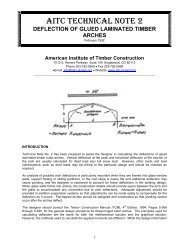Laminated Timber Design Guide - American Institute of Timber ...
Laminated Timber Design Guide - American Institute of Timber ...
Laminated Timber Design Guide - American Institute of Timber ...
Create successful ePaper yourself
Turn your PDF publications into a flip-book with our unique Google optimized e-Paper software.
Fire Safety and Inspection<br />
Heavy <strong>Timber</strong> Construction<br />
Heavy timber construction has<br />
long been recognized by the<br />
model building codes as fire<br />
resistant. To receive building<br />
code acceptance as “heavy<br />
timber,” limitations are placed<br />
upon size and thickness or<br />
composition <strong>of</strong> all load carrying<br />
wood members. Heavy timber<br />
also avoids concealed spaces<br />
under floors and ro<strong>of</strong>s and<br />
requires the use <strong>of</strong> approved<br />
fastenings, construction details<br />
and adhesives.<br />
The performance <strong>of</strong> heavy<br />
timber construction under fire<br />
conditions is markedly superior<br />
to most unprotected noncombustible<br />
structures. Fire<br />
fighting is simpler and safer due<br />
to elimination <strong>of</strong> concealed<br />
spaces and the inherent structural<br />
integrity <strong>of</strong> large glued<br />
laminated timbers.<br />
Unprotected metals lose their<br />
strength quickly and collapse<br />
suddenly under extreme heat.<br />
Steel weakens dramatically as its<br />
temperature climbs above 450°<br />
Fahrenheit, retaining only 10% <strong>of</strong><br />
its strength at about 1380°F. The<br />
average building fire temperatures<br />
range from 1290°F to 1650°F.<br />
Wood retains a significantly<br />
higher percentage <strong>of</strong> its original<br />
strength for a longer period <strong>of</strong><br />
time, losing strength only as<br />
material is lost through surface<br />
charring.<br />
www.aitc-glulam.org<br />
Heavy timber contruction.<br />
Fire Resistance<br />
The fire resistance rating is the<br />
time a member can support full<br />
design load without collapsing or<br />
spreading fire, either directly or<br />
indirectly through heat transfer.<br />
For example, a one-hour rating<br />
means the assembly should be<br />
capable <strong>of</strong> supporting its full load<br />
without collapsing for at least one<br />
hour after the fire starts.<br />
Fire <strong>Design</strong> Method<br />
Fire tests jointly sponsored by<br />
the <strong>American</strong> Forest & Paper<br />
Association and AITC led to a fire<br />
design methodology which allows<br />
the designer to calculate a specific<br />
fire rating for a glulam member.<br />
See AITC Technical Note No. 7.<br />
A typical glulam beam following a fire test.<br />
The outer surface <strong>of</strong> the beam has<br />
charred, while the inner areas remain<br />
unburned. The charred outer material acts<br />
as an insulator during fire, reducing the rate<br />
at which the inner material burns.<br />
Quality Control and Inspection<br />
As a service to the construction<br />
industry, AITC provides a<br />
quality control and inspection<br />
system based on three elements:<br />
1. Licensing <strong>of</strong> manufacturers.<br />
AITC licenses qualified<br />
laminators whose personnel<br />
procedures and facilities have<br />
complied with the requirements<br />
<strong>of</strong> ANSI/AITC A190.1.<br />
2. Quality control maintenance.<br />
Each licensee agrees to<br />
accept responsibility for maintaining<br />
a quality control system<br />
which is in compliance with<br />
ANSI/AITC A190.1, AITC<br />
standards, and AITC 200--<br />
Inspection Manual.<br />
3. Periodic plant inspection.<br />
AITC’s Inspection Bureau, a<br />
nationwide team <strong>of</strong> qualified<br />
inspectors, conducts frequent,<br />
unannounced inspection and<br />
verification checks <strong>of</strong> laminators’<br />
in-plant quality control system,<br />
procedures and production.<br />
15



